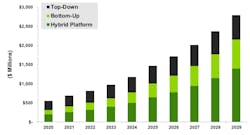Peter Asmus, research director at Guidehouse, describes the state of the market for microgrid controls — a technology known as the “brain” of the microgrid — and what companies are leading the way.
Peter Asmus, research director, Guidehouse
The success of the microgrid market depends on digital control platforms that can orchestrate diverse distributed energy resources (DER) into a single optimized aggregation system. Although the big-ticket items for any microgrid are investments in DER assets such as solar PV and batteries, the key to project performance and the ability to extract value from these same assets are the controls, which often represent less than 10%, or even 5%, of total project costs.
Most often a combination of hardware and software, these control systems are the magic sauce, the brains and the orchestrator marshaling generation, storage and loads to bolster resiliency and optimize DER assets to meet prescribed economic and environmental goals. Controls platforms continue evolving. Emphasis is shifting from hardware devices and on-premise gateways to software and customization performed in the cloud.
Total annual microgrid controls spending reached $551.5 million in 2020, but Guidehouse Insights expects that annual tally to increase to almost $2.8 billion annually by 2029, a compounded annual growth rate (CAGR) of 19.8%. All told, more than $14 billion cumulatively is expected to be invested in microgrid controls over the next decade.
Top-down versus bottom-up
Perhaps the most revealing of microgrid control trends are debates regarding top-down versus bottoms-up control architectures. Top-down control approaches led the early microgrid market when most DER assets were baseload fossil fuel generators. Emphasis eventually shifted to more bottoms-up control approaches as a greater variety of renewable DER assets, often governed by smart inverters, were bundled into microgrids. This trend pushed intelligence to the grid edge, with many vendors moving to a more distributed approach by embedding intelligence via inverters and other hardware devices such as digital relays at each DER asset.
This shift also accommodated a more decentralized decision-making transformation. Traditional top-down relationships between devices — whereby one DER asset serves as a prime mover (or emulates a prime mover via virtual inertia) — gave way to new ways of microgrid orchestration. More recently, innovation in decentralized optimization has moved beyond on-premise distributed controls to the cloud. This innovative approach echoes the arguments on behalf of modular microgrids for which hardware components are increasingly commoditized. The thinking behind this shift to the cloud is that it reduces costs and enables quick modifications to microgrids that accommodate changes in regulation, DER switch-outs and optimization for specific priorities without ever needing to go on-site. COVID-19-related impacts reinforce this thinking as vendors discover ways to commission projects in an era of social distancing and shifting designations of whether a project is deemed an essential business activity.
Yet there is a downside to full reliance on the cloud. One smaller vendor that focuses on a low cost, on-premise device decentralized system noted that he had been asked to revive a project by a cloud-based startup that went bankrupt. “The only way to get that project up and running would be to hack the system,” he observed. Though he does rely on the cloud for some higher-level optimization, he noted that he relies on two internet providers as a form of virtual resiliency. One microgrid has survived two fires so far by allowing local controls to perform fundamental operations when the internet was down because of grid outages.
Comments such as these underscore why a hybrid approach will lead the controls market over the long run, especially for grid-tied systems such as those deployed in the lower 48 states. Bottom-up controls spending starts out the smallest at $112.7 million in 2020, increasing to $755.1 million by 2029 at a CAGR of 23.5%. By the end of the forecast period, bottom-up spending is greater than top-down spending. Hybrid platform controls spending starts at just $200.8 million in 2020, increasing to nearly $1.4 billion by 2029 at a CAGR of 24.1%. This approach is the fastest growing microgrid controls approach, just edging out the growth rate for bottom-up controls spending.
Microgrid Controls Spending by Fundamental Controls Approach, World Markets: 2020-2029
Who are the market leaders on microgrid controls?
Comparing apples to apples in the controls space is extremely difficult due to the array of technologies deployed to control microgrids that range in size from kilowatt-scale all the way up to systems over 2 GW. These control technologies include the following:
- Smart inverters
- Digital and mechanical relays (often linked to hardware devices such as switchgear)
- Programmable logic controllers, which allow for specialized code to integrate diverse DER assets
- SCADA, a standard data platform long used by energy providers that can be adapted to serve as a microgrid controller at the most fundamental level
- Distribution automation platforms that utilities rely on to optimize distribution networks, including microgrids, in grid-tied and remote applications
- Advanced software incorporating emerging technologies such as AI and Internet of Things systems
Many larger vendors can offer control products that span this list; others focus more on certain key components. In a recent Leaderboard report, the same two companies that ranked the highest in 2018 remained at the top of the heap: Schweitzer Engineering Labs (SEL) and Schneider Electric. SEL and Schneider offer contrasting strengths — SEL offers a low cost, market-leading technology for seamless islanding while Schneider Electric is pioneering new energy as a service business models for microgrids. The third market leader is Siemens, which has expanded its microgrid offerings and helped develop leading-edge microgrids across multiple geographies (see the following chart).
The Guidehouse Insights Leaderboard Grid
Courtesy of Guidehouse Insights
Fierce market competition is evidenced by the number of companies that have come and gone over the past decade, the increased number of recent acquisitions and the number of large established players that have revised their offerings with new technology and business models.
As one indication of the turnover and churn in the market, five vendors included in the 2018 Leaderboard report are no longer included and five new companies are in this 2021 report. Among the new companies is PXiSE Energy Solutions, which is focused on utility deployments and offering distributed energy resource management system (DERMS) solutions along with microgrid controls. This speaks to the trend of companies trying to offer platforms that span the entire DER management universe: microgrids, DERMS and virtual power plants. Another example was the acquisition of OSI, a DERMS provider, by Emerson Automation. CleanSpark, which benefited from an infusion of $44 million in aggregated investment last year, acquired the firm GridFabric in August 2020, a middleware firm that helps the company expand its reach into adjacent Internet of Things (IoT) markets and expand its footprint with aggregators and utilities.
One of the most interesting newcomers is Heila Technologies, which was birthed at the Stone Edge Farm in Sonoma, California. Heila EDGE is an end-to-end modular platform that brings intelligence to the grid’s edge. With Heila EDGE, each DER becomes an independent agent capable of determining at split-second intervals the most beneficial operating point relative to system-level objectives. With the ability to run directly on-premise using rugged Heila controllers, or through a cloud-based platform, the Heila EDGE platform is flexible and scalable. This is exactly the direction we need to go in order to mainstream microgrids and address the interoperability challenges facing the industry as microgrids grow more diverse but seek to be more modular and scalable.
Interested in learning more about how microgrids operate? Join us at Microgrid 2021: The World Awakens to Microgrids, a free virtual conference hosted by Microgrid Knowledge. Participation is free for those who register in advance.








